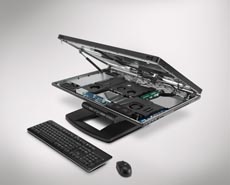Personal clouds seem to be on everybody’s lips these days. Frequently referred to as the new era of personal computing, the clouds are indeed revolutionary, but what exactly are they and what can they do for us? Essentially, personal clouds are online services that allow consumers to store, share, synch, protect and stream data using multiple connected devices such as smartphones, media tablets and PCs over the internet. Gartner, Inc, a technology research and advisory firm known for delivering specialized insight on various IT areas, acknowledges the huge impact of personal clouds on individual users and expects it to replace the personal computer at the center of our digital lives by 2014. “Major trends in client computing have shifted the market away from a focus on personal computers to a broader device perspective that includes smartphones, tablets and other consumer devices,” Steve Kleynhans, research vice president at Gartner, said in a statement. “Emerging cloud services will become the glue that connects the web of devices that users choose to access during the different aspects of their daily life.” As a result, the future looks even brighter for technology developers. According to Gartner, consumers will spend approximately $2.2 trillion on digital technology products and services in 2012, or about 10 percent of the average disposable household income. By 2015, consumers are expected to spend around $2.8 trillion worldwide on connected devices, affiliate services and transferred contents. Regarded as a real breakthrough in the field of information technology, personal clouds promise to deliver smart solutions to experimented digital users. While consumer needs are extremely varied and expectations differ greatly, the general requirements involve availability, security and access to personal contents without complications or restrictions. This is exactly what personal clouds aim to be, a reflection of...
Pinning Properties
Visual social marketing
Launched in 2010 by Ben Silbermann, Pinterest has established a world record – the fastest website to break the 10 million unique visitor mark. But this viral social site is not only about pinning pretty pictures from your interests on a virtual board. It is also a powerful and intriguing marketing tool for some businesses, including property management companies. We now have the luxury of social media platforms that can cater to specific corporate needs. When it comes to property management, there is nothing more important than branding your property. Houzz.com offers a valuable lesson in this respect – the emphasis on the aesthetic quality of a residence is king on the Internet. Pinterest throws in great social interaction which can help mobilize products through its “look and share” approach. An important factor here is comprehension of your demographics. If your community has a target market of seniors, you probably don’t need to waste your time with Pinterest. If you’re targeting the 20-40 crowd, pin away. You’ll also need a strategic marketing strategy incorporating SEO keywords. Your content should reflect your company. Create boards for interior design and for furnishing – anything that complements your properties. As long as you produce and repin interesting content, you are bound to generate traffic and attract potential customers. In addition, a property management company should make use of the platform’s video functions. The other value of Pinterest is as a tool for tracking customer trends and preferences. One glance at the site’s main board can offer ideas for redesign and refurbishing your property. Out of touch with what staging providers should be incorporating into your look? Pinterest can bring you up to speed fast. Scouring Pinterest for property management companies that actually understand social media marketing has...
Do-It-Yourself Computing...
Taking DIY high tech
Do-it-yourself computing has gained momentum in recent years as individuals and businesses seek out ways to eliminate avoidable expenses. Such new technologies may minimize personnel requirements and middle man costs while optimize workplace efficiency. Meet Z1, the future of DIY computing The new HP Z1 workstation aims to reduce user dependency on third party technicians. At first glance, the Z1 is reminiscent of an iMac. The compact, tower-free model is based on an all-in-one design that looks like an effortlessly stunning 27’’ monitor. Upon a closer look, users discover that the monitor can be folded down, flush with the surface upon which it stands. The workstation can then be opened as one would open a laptop. Inside rests the hard drive, memory, and other vital components that can are easily disengaged; no tools are required. Users can easily change out components of the system without much risk. When it is time to upgrade the graphics card or increase the amount of available memory, there will be no need to call a technician. Users may simply order the part online and pop it in themselves. The Energy Star approved Z1 is scheduled for release to the public in April 2012, starting at $1,900. Z1 is the only workstation of its class in the world. Workstation limitations Z1 (and models like it that will undoubtedly follow) do not allow businesses to completely eliminate the IT department altogether. The time and resources needed for basic maintenance may be significantly reduced, yet access to professional services is still a requirement long into the foreseeable future. For example, a layman may easily switch out the hard drive on a Z1 but it will take a specialist to troubleshoot performance problems within the hard drive. Businesses will need the input...
Google’s New Privacy Policy...
What it means for you
If you have any Google services (and who among us does not?) then you probably received multiple notices that on March 1 Google implemented a new privacy policy designed to replace a hodgepodge of 60+ old privacy policies, spread across an array of their services. Google gives their take on it here. The bottom line is, Google keeps and uses a lot of your personal online data: search queries, browsing habits, contacts, emails, and more. If you are interested in minimizing (or completely eliminating) the data that Google keeps, you have options available. Managing your accounts Want to get a handle on your account(s) and maximize your privacy options? Here are some suggestions to help keep sharing to a minimum: Log in to your Google dashboard to get an overview of your Google accounts & services. Explore a little and clear services & data you do not want under your account. Clear your web history – this will erase all items from your web history and stop your web history from being recorded in the future. From your web history page, just click “Remove all Web History.” Opt out of personalized ads. These are generated based upon your search queries or content in Gmail messages. To disable, simply go to your ads preferences page and click “Opt out.” Download your data. Google Takeout allows you to download a copy of all your data stored in Google products. This gives you a bird’s eye view that can help you pick and choose what to keep and what to eliminate. Note: not all products are currently supported. All of these options include varying levels of customization for partial elimination of data sharing: clear only parts of your web history, block only certain advertisers, etc. Taking your...
New iPad arrives – What can it do for you?...
Mobile business solutions
Property management firms are increasingly likely to turn to mobile devices like iPads to aid in the on-site residential lease-up process. IT managers for major multi-family and commercial management firms say that they’re using the devices to keep their employees better connected, impress potential residents, and steam line business processes. This week, Apple gave the public a sneak peek at its latest release, the new iPad (commonly known as the iPad 3). While there are still quite a few user requests that have gone unfulfilled, the new iPad boasts multiple noteworthy advancements. Memory & Processing The new iPad unveils the A5X, a more efficient way to do business. This ARM chip is touted to operate twice as fast as NVIDIA’s Tegra 3 quad core processor. Users are now able to access and run multiple applications with speed and agility. Connectivity Connect via HSPA+ (21Mbps), DC-HSDPA (42Mbps), and LTE (73Mbps) on Apple’s premiere tablet, which works excellently for travelers that may be in and out of 4G LTE range. Enjoy quicker access to multiple Virtual Private Networks via Wi-Fi or cellular data network connections. The range of connection options allows users to work seamlessly with the fastest connections available on the market. The hourglass and loading bar are relics of the past. In place of the Bluetooth 2.1 with EDR technology, new iPad users receive the solid Bluetooth 4.0. Additionally, users can operate the device as a personal hotspot and connect to other devices via USB. Display Apple’s newest tablet flaunts a crisp, stunning Retina display with 2048 by 1536-pixel resolution—at only 264 pixels per inch; it seems as though Apple was holding back, not pushing the envelope in terms of sharpness. Even with that detail in mind the screen resolution is better than comparable...
Moving to the Private Cloud
With the Private Cloud, the Sky is Truly the Limit
What’s the next big move for companies wanting to keep their business’ IT infrastructure, applications, and support management in step with the latest trends? If your business is struggling with servers that are out of date or need to be replaced, or you just want to be more nimble and future-focused while maximizing cost-effectiveness, perhaps you’ve thought about moving your applications and data to a private cloud. The much-discussed clouds are the latest wave of advancement for information technology and best practice business management. One predictive analysis forecast that the private cloud computing market will grow from $40.7 billion in 2011 to $241 billion in 2020, over several dozen distinct market segments. Other forecasts put that number significantly higher. Cloud services growth is expected to contribute to 14 million new jobs, worldwide, by 2015. Recently initiatives by Microsoft, GoDaddy, expansion by industry pioneers like Amazon, and an influx of venture capitalist funding have fast-tracked the private cloud market for major growth. “Making the move to the private cloud will be the next big step for forward-thinking businesses who want to maximize their information technology efficiency,” said Scott Wiener, Senior Vice President of Information Technology for Yardi Systems. The options for cloud users are nearly endless, with service providers offering a wide range of options for network configuration, security, replication and access protocols. As your company prepares to move into the future, consider the following factors: Is a cloud right for your company: -Will you be able to achieve your goals of budgeting and cost-savings by going the cloud route? -Will there be any aspects of how you do your work or conduct your business that would be affected or improved? -How will current onsite IT personnel be involved in the changeover to the cloud? -What is the time frame for implementation, transition, and network setup? Selecting the right cloud provider: -What are the resources of the cloud provider you’ve selected, including the experience and qualifications of their personnel, types of equipment, and years of involvement in the technology industry? -What type of initial audit and assessment of your current onsite network will the cloud provider conduct, and what factors will be included in their review? -How many companies is your cloud provider working with, and can they provide corporate references? How will the transition to the cloud take place: -Who will be responsible for system updates, versioning, licensing agreements and patches? -What will be the level of security controls provided for your cloud and how will they align with your corporate standards? -Is the provider at the highest level of SLA and offering a proven mature support system? -How will on-site desktops be maintained? This long awaited innovation in computing has arrived as a cost and efficiency saver for companies of all sizes, and some major technology companies, including Yardi Systems, are extending their years of best practices and cloud computing experience to meet any client needs, regardless of complexity. For those unfamiliar with the concept of private clouds, they are an extension of your onsite corporate network. Companies can choose how much of their network they wish to retain on on-site servers, and some are making full transitions to all-cloud networks. Imagine an office where the only technology you needed to run your company was Internet access. Could you run your company from a tablet computer, or have all your employees on Wyse thin client terminals with minimal infrastructure? It’s possible with the private cloud. Management protocols Companies moving to clouds should have the option to manage their private cloud as much or as little as desired. The beauty of the private cloud is that all aspects are customizable. Network management, including hardware, software, and support can be self-managed by the client or completely managed by external experts. Provisions can be made for speed requirements – for example, a company with a need for near-instant access to certain...
Flying High with 4G
Better WiFi in the friendly skies
If you have not yet given in to the temptation to splurge on in-flight Wi-Fi, you are not alone. USA Today offers a relatively dismal assessment of the current state of the business. The low-lights include only a seven percent sign-up rate in 2011, and a tech bottleneck that severely limits bandwidth. The biggest barrier is convincing passengers to shell out up to $15 per flight, give or take, for the same subpar Wi-Fi service they get for free in the terminal. However, change is in the air. Qualcomm is looking to rewrite the rules with its proposed in-flight 4G service, currently code-named ‘Next Gen-AG.’ That’s bad news for current in-flight 3G leader Gogo and rival Row44, but good news for passengers who want a robust connection at 30,000 feet. Qualcomm’s plan calls for about 150 cell towers to serve the nation’s skies, utilizing 500MHz of spectrum in the 14GHz band. What exactly does that get you? All the online services you currently enjoy on terra firma, while in the air. The new cell towers connect directly with the planes (mobile devices do not have enough oomph to reach down for service from cruising altitude), which means each tower will distribute capacity among hundreds of planes at any given moment. At 300Gbps there is more than enough to go around. This would allow airlines to offer on-demand entertainment to each seat, as well as parcel out bandwidth to paying passengers via Wi-Fi. Next Gen A-G is far from imminent. Qualcomm is currently in the petitioning process, asking the FCC to clear that huge parcel of spectrum. Once the spectrum is cleared, it goes up for auction. Row44, which provides in-flight Wi-Fi for Southwest flights, is opposing Qualcomm’s proposal on various grounds, chiefly a lack of need and potential interference with adjacent bands. The broadband network provider is being aggressive with its plans. Most importantly, Qualcomm has the support of American Airlines, Virgin American, and Delta Airlines, this according to filings with the FCC. With a full-court press officially on, expect the petitioning timetable to move quickly. On Jan. 30, the FCC responded with its first draft of several technical questions, which Qualcomm answered the very next day. One important question remains: will passengers care enough about the extra bandwidth to pay for it? Aside from the cost barrier, there is a psychological one. For many travelers, airplanes offer a convenient opportunity to unplug and find refuge from the office. But 4G service promises access to a host of cloud-based goodies: movies, TV episodes and webisodes, music, gaming, and more. What do you think – have you used any of the current in-flight Wi-Fi services? Do you want to stay plugged in (for work or entertainment) while you are in the air, or would you miss the luxury of hanging out a “Gone Fishin’” sign while you...
Raspberry Pi
Affordable tech trends
When I first heard about Raspberry Pi, I started thinking about summer baking season. Then I started checking out the extensive publicity received by this British-based accessible computing project and got more excited about its potential as food for thought. The $32 computer, comprised of naked components on a board, went on sale Feb. 29 to great fanfare, and the first batch of available devices sold out within an hour. RasPi, as it is also known, is the innovative design of a PC that’s only the size of a credit card. The intent is to provide the cheapest possible computer, with a basic level of functionality, to give access to technology to those who could not otherwise afford it. Sales are expected to be so brisk that initial orders are being limited to one piece of Pi per person. So far, it is acquiring equal parts acclaim and hand-wringing in the British press – the hand-wringers see the device as taking a step backwards in its simplicity. They argue that its users don’t need to recreate past simplistic programming experiences and that the device lacks the power to really have an impact. The RasPi developers have created a charity that won’t get rich from the sales of their device, but instead will reinvest all the proceeds in better educating kids around the world about programming. One of their many goals is to get the RasPi into classrooms that wouldn’t otherwise have access to computers. They also want it to fall into the hands of those for whom a $350 laptop would be an improbable extravagance. They’ve answered all the tech spec questions about their device on their website; see a diagram about how the computer is laid out at right. The company puts it...








